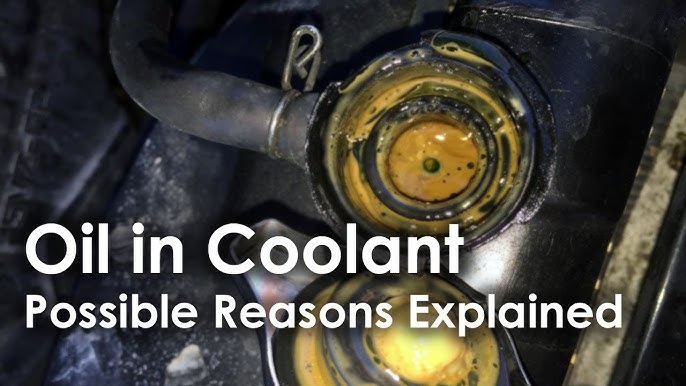One of the most serious issues a car engine can face is when oil and coolant start to mix. This is often a signal of a critical internal problem. Once coolant leaks into the engine oil, it can cause severe damage, and ignoring it could lead to expensive repairs. In this guide, we’ll cover how coolant and oil can mix, the signs to watch for, and the steps to fix and prevent this issue.
Why Is There Oil in My Coolant?
When coolant is found in the oil, it’s generally due to a mechanical failure in the engine. Here’s what usually causes this:
- Head Gasket Failure
The head gasket separates the oil and coolant channels in the engine, ensuring they don’t mix. If this gasket fails, it can allow these fluids to pass through and mix. - Engine Overheating
Overheating can damage the gasket or even crack parts of the engine. When the engine becomes too hot, seals that keep oil and coolant separate can weaken, causing them to mix. - Physical Damage to the Cylinder Head or Engine Block
Accidents or intense overheating may also crack the cylinder head or engine block. This creates pathways for coolant and oil to mix.
Tip from an Expert: Even a small leak can worsen over time. I’ve seen minor gasket leaks turn into major engine repairs because they were ignored too long.
Is Coolant in Engine Oil Dangerous?
Having coolant in your oil can be devastating for your engine. Here’s why:
- Oil’s Purpose: Oil lubricates engine parts, reducing friction and preventing overheating.
- Coolant’s Purpose: Coolant keeps the engine temperature stable, preventing overheating.
- What Happens When They Mix: When coolant contaminates oil, it disrupts the oil’s ability to lubricate effectively. This can cause parts to grind against each other, overheat, and wear down rapidly. The results are poor engine performance, excessive smoke, and ultimately, severe engine damage if left unchecked.
Fact: A coolant-oil mixture has a distinct appearance. When oil mixes with coolant, it often creates a thick, milky substance that resembles gravy or sludge. This is a tell-tale sign of contamination and requires immediate attention.
How to Tell If Oil and Coolant Are Mixing
Detecting oil and coolant mixing early can save you from a costly repair. Here are common signs:
- Milky Substance in Oil or Coolant Reservoir
When checking the oil or coolant, look for a milky, thick texture. A coolant-oil mixture often turns brownish or looks like gravy. - Overheating Engine
If your car’s engine temperature is higher than normal, this could indicate coolant loss or contamination. - Performance Problems
You may notice loss of power, rough idling, or smoke from the exhaust.
Step-by-Step: How to Check for Coolant-Oil Mixing
- Inspect the Dipstick
Pull the oil dipstick and inspect the color. If it’s not a clean brown or black but appears milky, coolant may be in the oil. - Look Inside the Coolant Reservoir
Check the coolant reservoir for a similar texture or color change. - Start the Engine and Observe
Start the car and let it run for a few minutes. Look for excessive smoke from the exhaust or an unusual engine sound.
How to Fix Oil in the Coolant Reservoir or Coolant in Oil
If you spot this problem, here are the basic steps you can take:
- Flush the Coolant Reservoir and Radiator
- Remove the old coolant and flush the radiator with water to remove contamination.
- Change the Oil and Oil Filter
- Since coolant in oil compromises the oil’s quality, do a complete oil change.
- Replace the oil filter to remove contaminants thoroughly.
- Consider Using Additives for Temporary Sealing
- High-quality additives, like Hy-per Lube Oil Supplement, can seal minor leaks in the piston rings and valve guides. This can sometimes reduce small leaks and improve engine performance.
- Use Hy-per Cool Super Coolant to improve cooling efficiency and lower engine temperature.
- Seek Professional Help if the Problem Persists
If you’ve done all of the above and still experience overheating or see milky oil, it may be time to have a mechanic inspect the engine for a blown head gasket or other critical damage.
Did You Know? Not all coolant-oil mixtures indicate a catastrophic problem. However, if the issue continues after these steps, more extensive repairs might be necessary.
How Much Will It Cost to Fix Coolant in My Oil?
Repair costs depend on the severity of the issue. Here’s a breakdown:
- Basic Repairs (Fluid Replacement and Additives)
If you only need to replace fluids and add a stop-leak product, this might cost $100 to $200. - Head Gasket Replacement
A blown head gasket is more costly, often ranging from $1,000 to $2,000 depending on the make and model of your car. - Engine Replacement
If the engine block is cracked, you’re looking at a serious expense, potentially $4,000 to $8,000 for a new engine. This is generally a last-resort repair.
Prevention Tips for Avoiding Coolant and Oil Mixing
- Regularly Inspect Your Engine Oil and Coolant
Check the oil and coolant regularly to spot contamination early. - Use High-Quality Products
Using products like Hy-per Lube Oil Supplement and Hy-per Cool Super Coolant can help protect your engine from wear and overheating. - Watch for Overheating
Overheating is a major cause of internal damage. Make sure your cooling system is functioning well and get it serviced as needed.
Expert Advice: If you notice your engine frequently runs hot, have it checked. Consistent overheating is often a sign of internal engine issues that could lead to coolant-oil mixing.
Conclusion
Coolant mixing with oil is a problem that requires immediate attention. While minor cases might be resolved by changing the fluids and adding quality additives, severe cases could demand major repairs. By staying vigilant and maintaining your engine properly, you can avoid costly issues and keep your engine in good health.
If you suspect that coolant and oil are mixing in your engine, consult a trusted mechanic or seek quality automotive products to protect your engine.



Pingback: Oil in Coolant: What Happens When engine Oil Mixes with Coolant ? - Oil for Car – Car Oil Reviews, Guides, & Car Tips